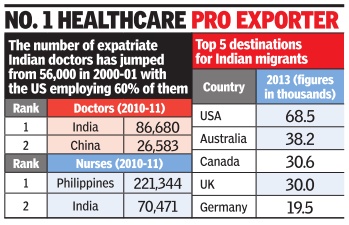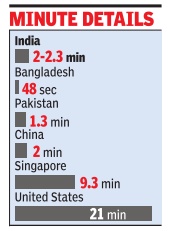Doctors in India
This is a collection of articles archived for the excellence of their content. |
Contents |
Availability of Doctors
2010-11: India world’s top supplier of doctors
Sources:
1. The Times of India, Sep 24 2015
2. The Times of India, Sep 24 2015, Lubna Kably

India top supplier of docs to west
India remains the top sup plier of expatriate doctors to 34 Organisation for Economic Co-operation and Development (OECD) countries, followed by China, reports Lubna Kably. According to a recent report, 86,680 Indian expatriate doctors worked in OECD countries, which include the US and EU bloc, during 2010-11 -up from 56,000 in 2000-01. The US employs 60% of expat Indian doctors; the UK is the second leading employer.
Philippines provided the most number of nurses at 2.21 lakh followed by India (70,471).
Health issues
Kerala doctors die earlier than general public
Nov 20, 2017: The Times of India
HIGHLIGHTS
Doctors in Kerala are dying younger when compared to the general public according to a study conducted by Indian Medical Association.
Majority of doctors in Kerala die due to cardio-vascular diseases and cancer.
Life expectancy of an Indian is 67.9 years and that of a Malayali is 74.9 years, the mean ‘age of death’ for a Malayali doctor is 61.75 years
Doctors heal and help people live longer, but it seems many of them are dying younger when compared to the general public in Kerala. A study conducted by research cell of the Indian Medical Association (IMA) in Kerala found that a majority of them die due to cardio-vascular diseases and cancer.
While the life expectancy of an Indian is 67.9 years and that of a Malayali is 74.9 years, the mean 'age of death' for a Malayali doctor is 61.75 years, said the study. "We were surprised by the figures as we expected doctors to live longer as they know what is good for them," said IMA research cell convener Dr Vinayan KP.
For the 10-year study - titled Physician's Mortality Data from 2007 to 2017 - the mortality pattern among doctors enrolled with state IMA's social security scheme was analysed. Of the 10,000 doctors who were part of the contributory supportive scheme that provides a fixed amount to deceased doctor's family, 282 died during the study period.
Of this, 87% were men and 13% women. Almost 27% died due to heart diseases, 25% due to cancer, 2% died due to infection and another 1% committed suicide.
The study didn't look at the reasons for early death, but doctors reasoned that stress was a major contributor. "Doctors are generally working under a lot of stress irrespective of government or private jobs. Increased working hours, the patients they attend to and high expectations contribute to this increased stress. Their working hours need to be fixed, besides government social security scheme. Also doctors should be prepared for periodic health check-ups," said IMA's former president Dr VG Pradeep Kumar.
"Being a doctor in India is injurious to one's health now. Due to stress, doctors are more prone to heart disease, diabetes and even paralysis," said IMA national president Dr KK Aggarwal. While IMA's national study showed that doctors were dying on an average 10 years earlier than the general population; in Kerala - a state with high life expectancy -they die nearly 13 years earlier.
IMA, Kerala is in the process of doing a prospective study on the health profile of all its members - their lifestyle, food habits. It also will see whether doctors themselves go for a regular medical check-up. "The present study is a retrospective study and has its limitations. We don't know the lifestyle and habits of those who died. Also some elderly doctors may not be part of the scheme as it is a voluntary one introduced much after IMA was formed here," said Dr Vinayan.
Health expert Dr B Ekbal (one of the few doctors in the state who is not an IMA member) said that a detailed study covering all doctors was essential before reaching a final conclusion. "This may be an indication about doctor's health, but a detailed study is needed," he said.
Quality of care of patients
Doctor-Patient ratio: 2007-14
The Times of India, September 24, 2015
Number of migrant healthcare professionals in OECD nations sees 60% rise
India continues to retain its position as the world's top supplier of expatriate doctors to 34 member countries of the Organisation for Economic Cooperation and Development (OECD), followed by China. Most new immigrants to OECD countries--taking migration statistics in totality--though, originated from China, with India occupying the fourth slot.
According to the International Migration Outlook (2015), the number of Indian expatriate doctors to the OECD jumped 55% to 86,680 in 2010-11 from 56,000 in 2000-01. The US employs 60% of the expatriate Indian doctors, with the UK being the second leading employer. China, with 26,583 expatriate doctors in 2010-11, was a distant second overall. The OECD includes, among others, the US, EU countries, Switzerland and Australia.
Philippines provided the most nurses--around 2.21 lakh--compared to India at 70,471. The number of expat nurses from India, though, has grown over the past ten years, which has seen India move to the second spot in 2010-11 from its sixth position earlier. Expat nurses from India are found primarily in the US (42%), the UK (28%) and Australia (9%).
In total, the number of migrant doctors and nurses working in OECD countries has risen 60% over the past ten years. Expat doctors and nurses constituted 23% and 14% of healthcare profes sionals in OECD countries.
“The trend mirrors the general increase in immigration to OECD countries, particularly of skilled workers,“ states the report, pointing out that a number of OECD countries have revised their migration laws in the past few years, hinging towards restriction.
Several countries have cast a greater onus on the potential employer to ensure expats only with right skills are granted employment--advertising for local employees and payment of a threshold salary for expat employees (to ensure that lower salaries don't become the sole ground for hiring expats) are among the measures adopted by various countries, especially those in EU.
The total foreign-born population in OECD countries stood at 11.7 crore people in 2013--3.5 crore more than in 2000. 2014 data suggests permanent migration flow to OECD countries reached 4.3 lakh--a 6% increase compared to 2013.
Most new immigrants to OECD countries originated from China, accounting for around 10% of migrants in 2013, followed by Romania and Poland. This is largely attributed to intra-EU mobility.Comparatively, India appeared in fourth position, with 4.4% of immigrants.
OECD countries have also seen an increase in the number of foreign students. In 2012, there were nearly 34 lakh foreign students in OECD countries--a slight rise of 3% compared to 2011. Most students in the area of higher education originated from Asia, with India accounting for 6%. International students account for an average of 8% of the OECD tertiarylevel student population.
On average see patients for 2 minutes/ 2017

From: Malathy Iyer, Docs in India see patients for barely 2 min: Study, November 9, 2017: The Times of India
The average time that India's neighbourhood doctors, called primary care consultants, spend with patients is a negligible two minutes. Neighbouring Bangladesh and Pakistan seem worse off, with the length of medical consultation averaging 48 seconds and 1.3 minutes, respectively, according to the largest international study on consulting time, published in medical journal BMJ Open.
Contrast this with firstworld countries such as Sweden, the US or Norway where a consultation crosses 20 minutes on an average. “It is concerning that 18 countries covering around 50% of the world's population have a latest-reported mean consultation length of five minutes or less. Such a short consultation length is likely to adversely affect patient care and the workload and stress of the consulting physician,“ said the BMJ Open study conducted by researchers from various UK hospitals. Patients are the losers here, spending more at pharmacies, overusing antibiotics and sharing a poor relationship with their doctors, said the study .
The shorter consulting time could mean larger problems in the healthcare system. In the Indian context, local experts said it is a reflection of overcrowded healthcare hubs and a shortage of primary care physicians.
Primary care doctors are different from consultants trained in a particular branch of medicine.
The finding of an average two-minute consult across India didn't surprise many .Health commentator Ravi Duggal said, “It is well known that patients get less time with doctors due to overcrowding in hospitals.“ Doctors in public hospitals end up consulting two to three patients at one time due to the crowds at OPDs. “It is, hence, not uncommon for doctors to mix up symptoms between two patients,“ he said.
Private clinics and hospitals are not less crowded. “Private doctors, especially general physicians, have such crowded OPDs that they only listen to symptoms and rarely conduct a physical examination,“ said Duggal, adding that a patient's quality of care gets compromised in the process.
Former Maharashtra Medical Council member Suhas Pingle blamed overcrowded clinics and the overburdened healthcare system.
There is also India's peculiar “prescription“ of a good doctor. “In India, we believe the best doctor is one who doesn't charge and is available 24x7.This is not practical,“ said Dr Pingle. Many doctors take lower charges so that they can get more patients. “Consultation length will obviously be shorter because there are only so many hours that a doctor can work,“ said the general physician.
The main difference between western and Indian consultation is the nature of the disease. The BMJ Open study looked at the overall picture of poor primary healthcare in countries.
Violence
40% of govt docs face violence
Study: 40% of govt docs face violence, Mar 21, 2017: The Times of India
Nearly one in every two doctors (41%) suffers violence at public hospitals, a survey conducted at Delhi's Maulana Azad Medical College revealed. The study covered 169 junior residents and senior residents, most of them working at Lok Nayak and G B Pant hospitals, reports Durgesh Nandan Jha. Verbal abuse was the most rampant form of violence, reported by 75% of respondents who said they had suffered some form of violence. More than half of such respondents (51%) reported getting threats and 12% said they had been physically assaulted. All doctors who faced physical violence said they felt angry, frustrated and fearful.
See also
Doctors in India
Medical education and research: India
Institute of Post Graduate Medical Education and Research, Kolkata
Jawaharlal Institute of Postgraduate Medical Education & Research (JIPMER), Puducherry